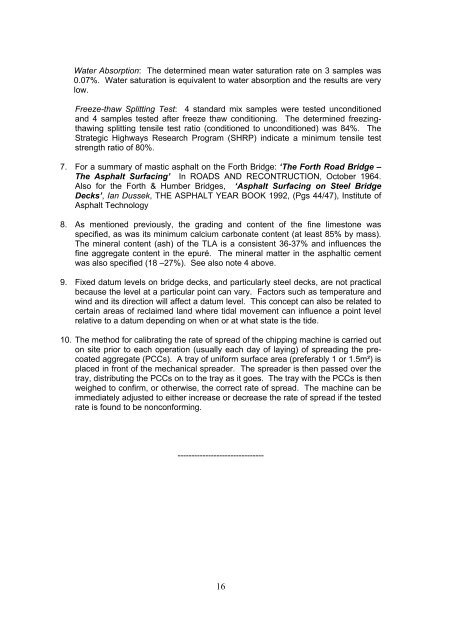MASTIC ASPHALT FOR PAVEMENT SURFACING
MASTIC ASPHALT FOR PAVEMENT SURFACING
MASTIC ASPHALT FOR PAVEMENT SURFACING
You also want an ePaper? Increase the reach of your titles
YUMPU automatically turns print PDFs into web optimized ePapers that Google loves.
Water Absorption: The determined mean water saturation rate on 3 samples was<br />
0.07%. Water saturation is equivalent to water absorption and the results are very<br />
low.<br />
Freeze-thaw Splitting Test: 4 standard mix samples were tested unconditioned<br />
and 4 samples tested after freeze thaw conditioning. The determined freezingthawing<br />
splitting tensile test ratio (conditioned to unconditioned) was 84%. The<br />
Strategic Highways Research Program (SHRP) indicate a minimum tensile test<br />
strength ratio of 80%.<br />
7. For a summary of mastic asphalt on the Forth Bridge: ‘The Forth Road Bridge –<br />
The Asphalt Surfacing’ In ROADS AND RECONTRUCTION, October 1964.<br />
Also for the Forth & Humber Bridges, ‘Asphalt Surfacing on Steel Bridge<br />
Decks’, Ian Dussek, THE <strong>ASPHALT</strong> YEAR BOOK 1992, (Pgs 44/47), Institute of<br />
Asphalt Technology<br />
8. As mentioned previously, the grading and content of the fine limestone was<br />
specified, as was its minimum calcium carbonate content (at least 85% by mass).<br />
The mineral content (ash) of the TLA is a consistent 36-37% and influences the<br />
fine aggregate content in the epuré. The mineral matter in the asphaltic cement<br />
was also specified (18 –27%). See also note 4 above.<br />
9. Fixed datum levels on bridge decks, and particularly steel decks, are not practical<br />
because the level at a particular point can vary. Factors such as temperature and<br />
wind and its direction will affect a datum level. This concept can also be related to<br />
certain areas of reclaimed land where tidal movement can influence a point level<br />
relative to a datum depending on when or at what state is the tide.<br />
10. The method for calibrating the rate of spread of the chipping machine is carried out<br />
on site prior to each operation (usually each day of laying) of spreading the precoated<br />
aggregate (PCCs). A tray of uniform surface area (preferably 1 or 1.5m²) is<br />
placed in front of the mechanical spreader. The spreader is then passed over the<br />
tray, distributing the PCCs on to the tray as it goes. The tray with the PCCs is then<br />
weighed to confirm, or otherwise, the correct rate of spread. The machine can be<br />
immediately adjusted to either increase or decrease the rate of spread if the tested<br />
rate is found to be nonconforming.<br />
-------------------------------<br />
16


